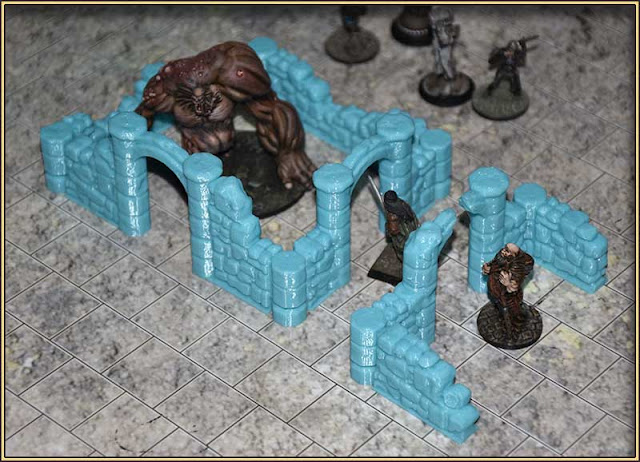I've just started printing some tabletop mapping components, designed by a chap called Ecaroth on Thingiverse, and named by him Dungeon Sticks.
They're basically interlinking half-height wall segments. Each piece has a male or female connector, or both: the particular ones shown here use an octagonal star socket and peg, so once assembled they are more or less locked in place (though there is still a little play). There are other versions that just use round pegs and holes, but they're more easily disturbed.
- First, because the half-height walls makes it easier for people seated around the table to see what's going on, and
- Second, because they're quicker and easier to put together in the heat of the moment, and they require minimal preparation.
- Third, because they're more generic than diorama tiles, they interfere less with the "theatre of the mind" that I think is so important a feature of tabletop roleplaying. The more detail that is presented on a tabletop scene, the more that it colours the imaginations of the participants, and the more precisely accurate it has to be, not to mislead.
No doubt I'll eventually get around to painting these, but I'm in no particular hurry. They are, after all, just a glorified substitute for dry-erase marker lines on my battle-map, and being blue doesn't really affect their functionality at all.
Ecaroth has created them in several styles as well as these stone walls — there are a couple of natural cavern styles, as well as a space opera-ish set of 'Space Station' walls. Also, he's provided a bare template set that one could create one's own custom designs with, which will come in handy if I should find a desperate need for something I can't jury-rig with the existing components.
They are taking a while to print though. A set of ten medium-length wall segments will be on the printer for about fifteen hours, so they're not the sorts of things I can dash out in a panic just before the game session starts.
I experimented with shrinking some of the "Space Station" components down for use with my old 15mm RAFM Traveller figures, but with only limited success.
These were printed at 60% scaling, and they'd really need to go down to 50% to be in scale with the figures. However, even at 60% the tolerances get too close; now that these pieces have been locked together, they're definitely not coming apart, and some of the walls in the door pieces are so thin that they're barely printing at all.
I think they'd probably be more useful for 15mm if I edited them to accommodate little magnets in their base, and just use them free-standing on a metal whiteboard.
Later on...
The Dungeonsticks are fine, as far as they go, but they do have their limitations. Having to accommodate the post and socket at each end means that they're not really truly modular; two "2" pieces aren't the same length as a "4" piece.
So, I've decided to just go with free-standing pieces that I've cut down from Fat Dragon's Dragonlock tiles. I cut away the tile base in Windows 3d Builder, deleted any free-floating remainders, and added sockets for 3x3mm magnets.
Larger magnets would provide a stronger attraction to the whiteboard (or whatever), but I have a whole lot of the 3mm magnets, and they stick well enough that the pieces won't fall over if the table is inadvertently bumped.
These sorts of scenery bits will be a lot more flexible than any sort of interlocking system, and I can create them from any tile system without having to worry about conforming to any particular connector type.




No comments:
Post a Comment